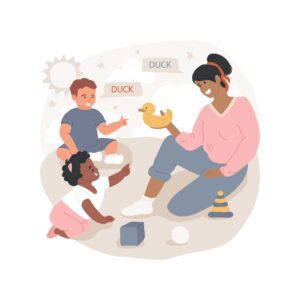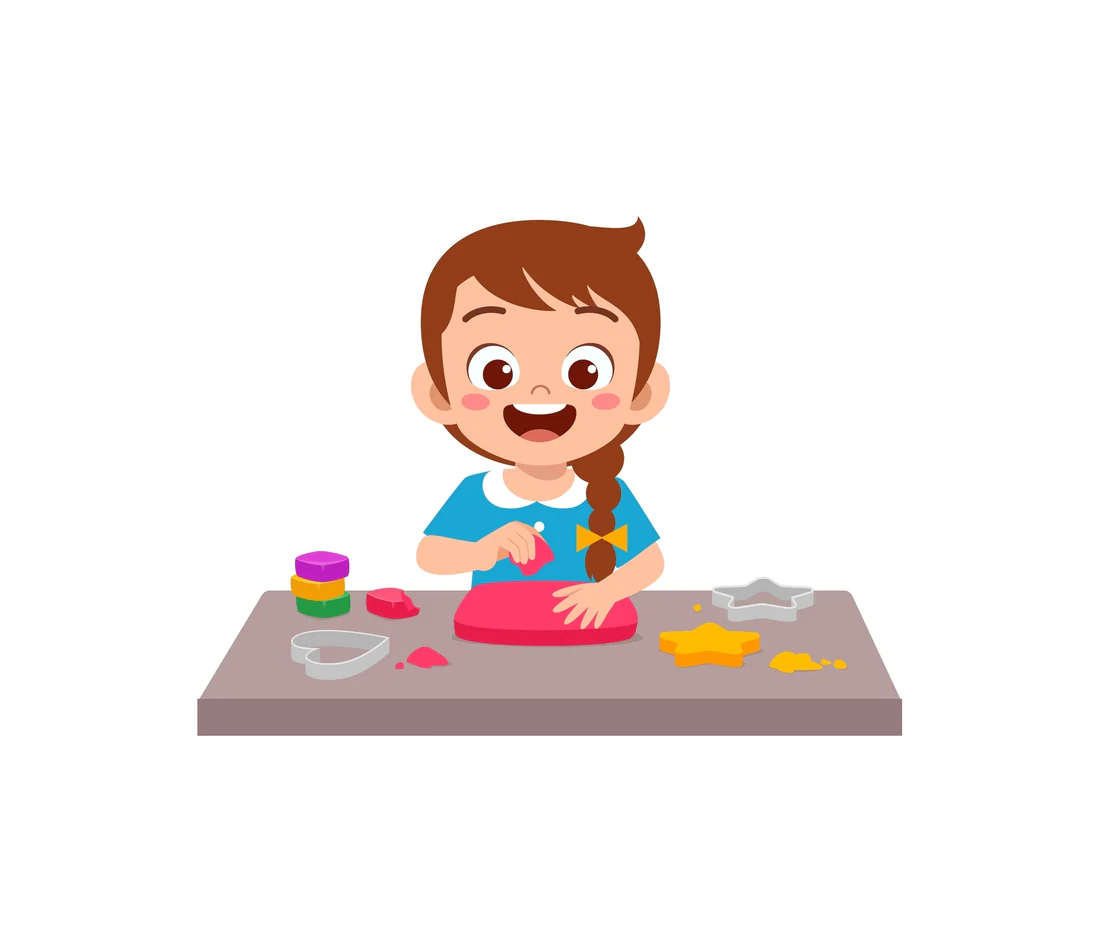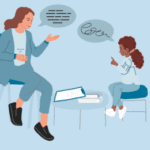
Blog
Typical Milestones in Speech and Language Development for Birth to Seven
July 25, 2024
Typical Milestones in Speech and Language Development for Birth to Seven
Speech and language development is a critical component of a child’s growth, encompassing a wide range of skills that evolve over time. Understanding these milestones can help caregivers and educators foster effective communication skills and address any potential concerns as they arise.

Birth to 3 Months
In the earliest stages of life, infants begin to communicate through cries, coos, and facial expressions. By around two months, babies start to make cooing sounds, which are the beginnings of vocalization. They respond to stimuli, showing interest in voices and sounds, and may even turn their heads towards familiar voices, indicating emerging social interaction.
4 to 6 Months
As babies approach the four-month mark, they typically begin to babble, producing repetitive consonant-vowel combinations like “ba-ba” or “da-da.” This is a significant step towards developing later speech skills. During this period, they also enjoy listening to music and may show preferences for certain sounds or rhythms.
7 to 12 Months
Between seven and twelve months, babies often begin to understand simple words such as “no” and “bye-bye.” They typically say their first words around their first birthday, with “mama” and “dada” being common staples. Non-verbal communication becomes more pronounced, with gestures like pointing or waving playing a vital role in their interaction with others.
Three Ways to Improve Infant Speech and Language Milestones
- Engage in Conversational Interaction: Talk to your baby frequently, even if they cannot respond with words yet. Use a variety of tones and expressions to make conversations engaging. Encourage turn-taking by pausing and allowing your infant to coo or babble in response. This helps them understand the flow of communication.
- Read Aloud Regularly: Sharing books with your infant is an excellent way to stimulate their language development. Choose picture books with bright colors and simple text. Pointing to images and naming objects can enhance vocabulary and comprehension, while rhythmic patterns in stories make the experience enjoyable and help with listening skills.
- Use Music and Singing: Incorporating songs and music into daily routines can promote speech development. Singing lullabies or nursery rhymes introduces rhythm and melody, which aids in language processing. Encourage clapping, dancing, or simple actions to make it interactive, fostering early engagement with sounds and language.
1 to 2 Years
At this stage, toddlers start to expand their vocabulary rapidly, typically learning about 50 words by age two. They begin to combine words into simple two- or three-word phrases, such as “more juice” or “mommy go.” Their ability to understand language grows, and they can follow simple commands, like “come here” or “sit down.”
Three Ways to Improve Toddlers’ Expanding Vocabulary
- Encourage Descriptive Language: When interacting with toddlers, use descriptive words to enhance their understanding and vocabulary. For instance, instead of simply saying “dog,” you might say “big brown dog” or refer to its actions by saying “happy dog running.” This technique helps toddlers learn new words by linking them to familiar concepts and experiences.
- Play Word Games: Engage in simple word games that encourage vocabulary expansion. Games such as “I Spy” or rhyming games can capture a toddler’s interest while introducing new words. Encourage them to describe what they see or make up silly rhymes, fostering creativity and word recognition in a fun way.
- Expand on Their Speech: When a toddler expresses themselves using simple words or phrases, expand on what they say. For example, if they say, “car,” you could respond with, “Yes, that’s a red car! It’s driving really fast!” This helps model more complex language and encourages them to build upon their existing vocabulary in a natural and engaging context.
2 to 3 Years
By age three, children often exhibit significant changes in their speech and language abilities. They might use over 200 words and form more complex sentences. This age marks the beginning of conversational skills, as they engage in basic dialogues, ask questions, and express their needs and feelings more effectively. Pronunciation may still be unclear, but they are generally understood by familiar adults.
3 to 4 Years
During the ages of three to four, children’s vocabulary continues to expand, and they typically begin to use sentences of three to five words. They can retell simple stories from books or events they have experienced. Their grasp of grammar begins to solidify, and they start using plurals and past tense. Social interactions grow more complex, as they engage in imaginative play and can follow multi-step directions.
Three Ways to Improve Language and Vocabulary in 3-4 Year Olds
- Encourage Storytelling: Facilitate opportunities for children to tell their own stories. This can be achieved by asking open-ended questions about their day or by inviting them to describe pictures from a favourite book. By creating a safe and engaging environment for storytelling, children can practice using expressive language and build narrative skills.
- Introduce New Concepts Through Play: Utilize playtime as a platform for learning new vocabulary. Incorporate themes such as cooking, gardening, or construction into playtime activities. Use descriptive language related to the activity, like naming ingredients or tools, and encourage children to express what they are doing, fostering both comprehension and verbal expression.
- Utilize Interactive Reading: Choose age-appropriate books and engage children with interactive reading strategies, such as asking predictive questions or encouraging them to point out pictures. Discuss the story’s characters, settings, and events in detail. This not only bolsters vocabulary but also promotes comprehension and critical thinking skills as children learn to connect words with their meanings.
4 to 5 Years
By the time children reach four to five years old, they usually have a vocabulary of over 1,000 words and can articulate more complex ideas. They engage in storytelling, using proper tenses and descriptive language. Their speech becomes clearer, making them understandable to strangers. They begin to understand the concept of rhymes and can identify some letters and numbers, laying the groundwork for literacy skills.
What to Do If Your 4 and 5-Year-Old Children Don’t Meet Vocabulary, Speech, and Language Milestones
If you notice that your 4 and 5-year-olds are not meeting expected vocabulary, speech, and language milestones, it’s important to take proactive steps to support their development. Here are some recommended actions:
- Consult a Pediatrician: Schedule a visit with your child’s health care provider to discuss your concerns. They can perform a screening to assess speech and language skills and rule out any underlying medical issues.
- Seek a Speech-Language Pathologist: A specialist can provide a comprehensive evaluation and identify any specific language delays or disorders. They can also create a tailored intervention plan to address your child’s unique needs.
- Create a Language-Rich Environment: Enhance your home with activities that stimulate conversation and vocabulary use. Engage your child in discussions about their interests, encourage them to ask questions, and provide them with opportunities to express themselves regularly.
- Utilize Educational Resources: Explore books, songs, and interactive games that are geared towards promoting language development. Consistent exposure to rich language can support their learning process.
- Monitor Progress: Keep track of your child’s speech and language development over time. Note improvements or any ongoing challenges, as this information will be valuable when discussing your child’s needs with professionals.
By taking these steps, you can help nurture your child’s communication skills and ensure they receive the support they need to succeed in their language development journey.
5 to 7 Years
In this final early childhood stage, children refine their language skills even further. They can produce longer, more detailed sentences and can discuss multiple topics in one conversation. They understand and use figurative language, such as expressions and idioms. Their literacy skills typically start developing in earnest, as they learn to read and write at school.
Strategies to Improve Reading and Writing in Home and School-Based Settings
- Establish a Reading Routine: Create a consistent time for reading each day, whether it’s before bedtime or after lunch. This fosters a habit and signals that reading is a valued activity. Encourage children to pick books that interest them, making reading enjoyable and engaging.
- Incorporate Writing Activities: Encourage children to keep a journal or write letters to family members. Providing prompts or themes (like daily events or favorite animals) can inspire creativity and facilitate practice in forming sentences and expressing thoughts uniquely.
- Support Interactive Reading: When reading with children, pause to ask open-ended questions that promote comprehension and critical thinking. For example, inquire about the characters’ feelings or predictions about the plot. This interaction deepens their understanding while encouraging expressive discussions.
- Use Word Games and Activities: Integrate games such as scrabble, crossword puzzles, or word searches into family time or classroom activities. These games make learning new vocabulary fun and stimulate interest in word exploration.
- Align Home and School Efforts: Communicate regularly with teachers about your child’s reading and writing progress. Reinforce what is taught in school at home by creating parallel activities or discussions, ensuring a cohesive learning experience.
- Explore Diverse Reading Materials: Include a variety of texts in your home library, such as fiction, non-fiction, magazines, and graphic novels. Diverse reading materials can capture a child’s interest and expose them to different writing styles and themes.
- Create a Print-Rich Environment: Label common objects around the home, display children’s artwork with captions, or post motivational quotes. A print-rich environment fosters an appreciation for reading and writing while helping children to view literacy as a part of everyday life.
- Incorporate Technology Wisely: Utilize educational apps and websites that focus on reading and writing skills. Interactive platforms can provide additional practice and exposure to literature, especially those that make learning multitiered and dynamic.
Implementing these strategies can greatly enhance children’s reading and writing capabilities, preparing them for academic success and fostering a lifelong love of literacy.
Recognizing and understanding the typical milestones in speech and language development is crucial for supporting children’s communication skills.
While every child develops at their own pace, caregivers should remain attentive to any delays or concerns and consult with professionals when necessary. Early intervention can often lead to more favorable outcomes, ensuring that children have the tools they need for effective communication throughout their lives. By nurturing these milestones, we can help pave the way for a lifetime of confident and articulate expression.











































































